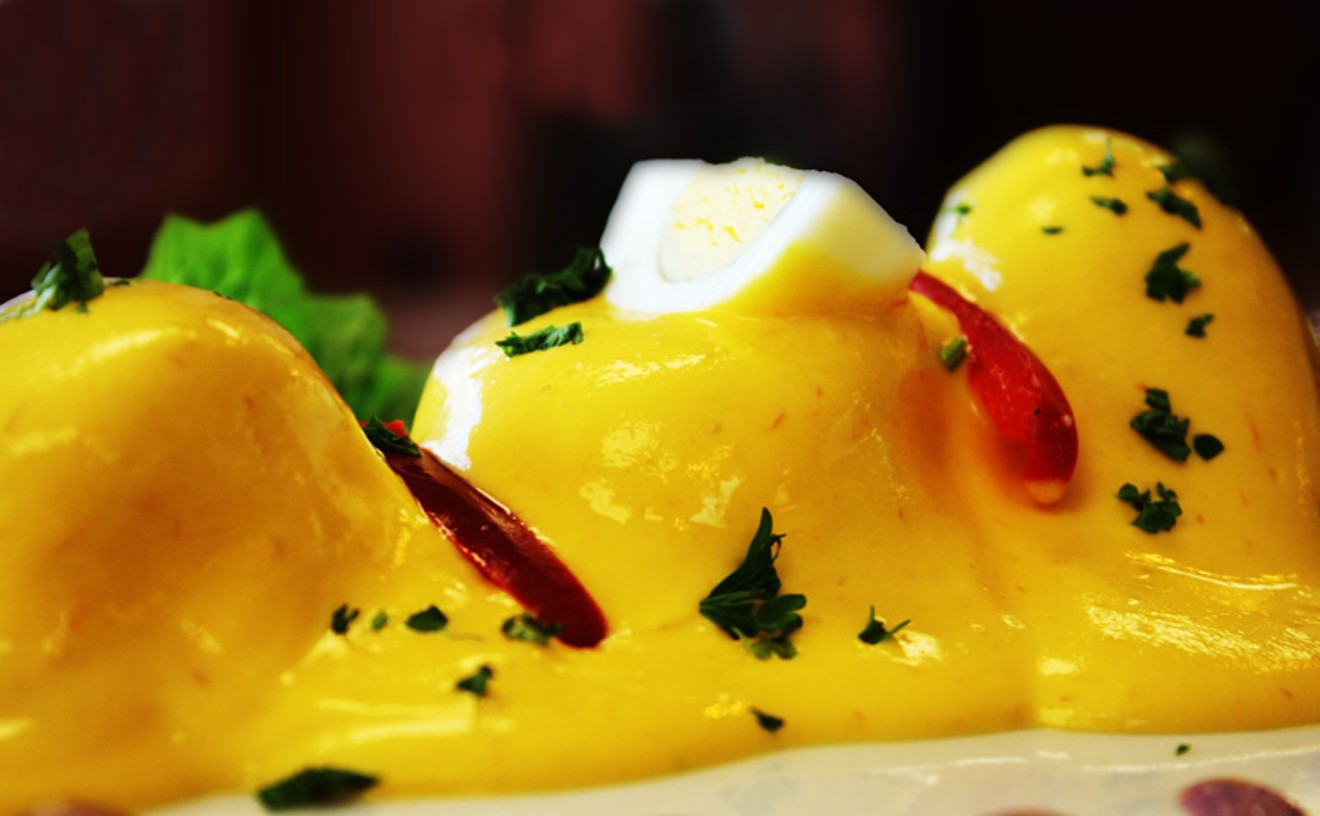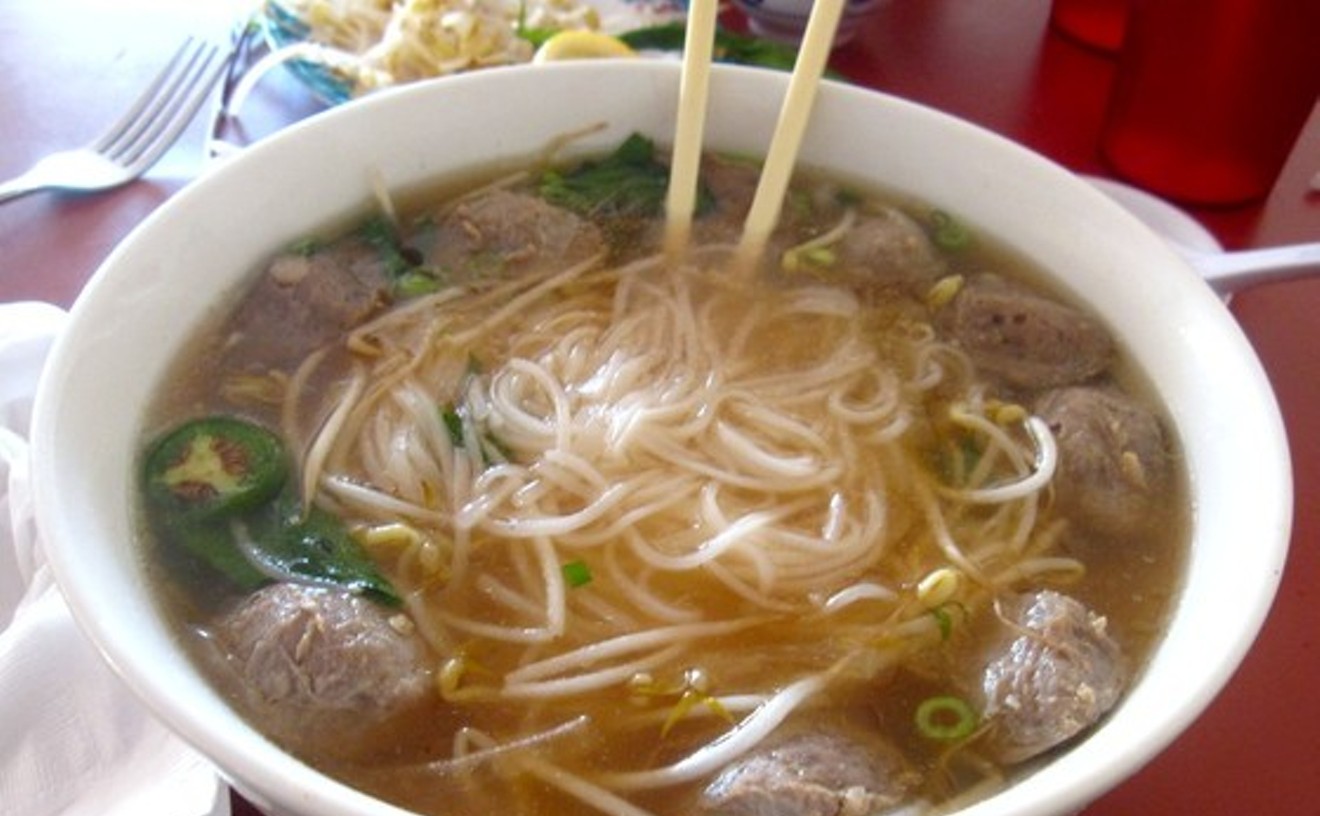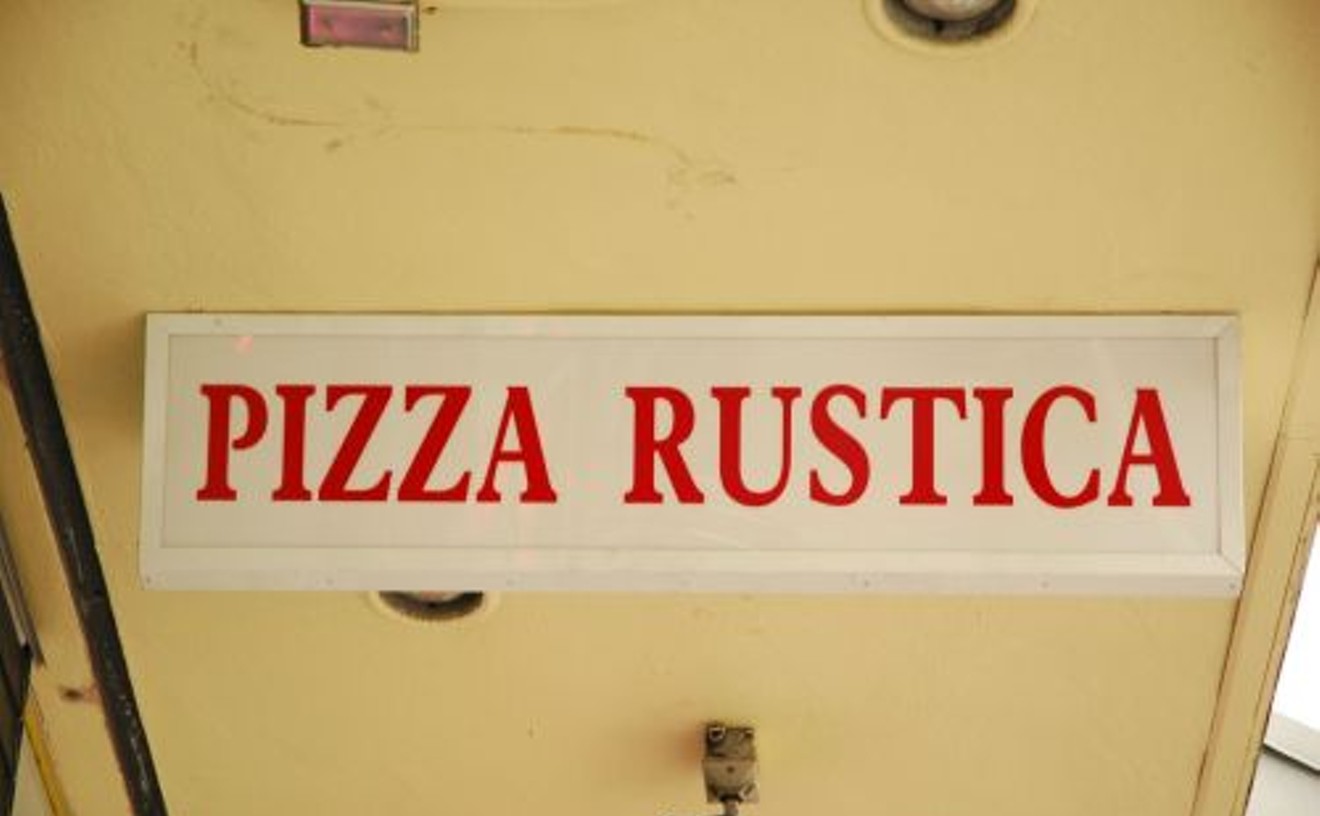Stephen Asprinio's Forté is a work of art. It's as though the 26-year-old proprietor, a contender on the first season of Top Chef, had designed his décor and menu to generate argument — and indeed, since it opened this spring, many have loved it and many have hated it. Even we who love it find our feelings shifting from week to week — pleasure, irritation, shock, despair, ecstasy — but the place never bores. There's a balance of tensions and what sometimes feels like deliberate anarchy, the occasional stroke of genius, and the inevitable flamboyant failure. But unlike restaurants that chart a safe course, Forté never shrinks from risk. The menu changes whimsically and sometimes frustratingly — you'll never meet the same amuse bouche; your favorite cocktail has been discontinued (the basil martini, although it was replaced with something even more delicious and elegant); the specific pairing of fruit compote with cheese (or mostarda with salumi) you raved over one night is ancient history. The menu has Italian genes, but in execution it's almost unbearably personal and not a little surreal, as if the butter poached lobster, the miniature pork chops with wild mushrooms and blackberry sauce, or those codfish "lollipops" had taken shape from a fevered dream.
Best New Restaurant in Palm Beach
Forte di Asprinio
- 225 Clematis St., West Palm Beach, 33401 Map
- 561-833-3330
- www.forteclematis.com
Best Organic/Raw Food Restaurant
Soma Center Café

A visiting friend of ours, professing that he "hated hippie food," ate his way through half the menu at Soma before he realized that what he was consuming was 1.) organic, 2.) vegan, and 3.) raw. We'd like to say he was a permanent convert to whole foods, but back home in New York he was instantly swallowed up again by a fleet of hot-dog carts. Still, he was our acid test, and we too occasionally find ourselves pondering the possibility — as we spoon up our bowl of quinoa soup or bite into a lettuce leaf wrap, a walnut-pate-stuffed tomato, or a homemade dairy-free cookie — that food that's good for you can also taste incredibly good. The Soma Center is one part yoga studio, one part meals-on-wheels, two parts wireless café, with a dash of dinner-club and afterhours party thrown in, and it's run by the nicest people on the planet. They'll deliver a daily raw food lunch to your door if you live in the neighborhood, but it's much more fun to stop in for a cup of fair trade coffee and a bowl of granola while the world dance class is going on in the front room, or to sit in the sun on the patio watching butterflies flitter through the potted pineapples. Soma puts on gourmet/vegan/raw/slow food dinner parties with wine tastings on an irregular basis, plus other events of an alternative nature, so call for their latest schedule.
- 609 Lake Ave., Lake Worth, 33460 Map
- 561-296-9949
- www.thesomacenter.com
Best Outdoor Dining
Dada
This wood-slat house, built in 1924, is such a throwback to old Florida that if it weren't for the sleek, artsy crowd sucking down cocktails and munching eclectic fare on its immense front porch, you might swear Dada was actually your Aunt Velma's country cottage, with tables occupying what should be a yard with chickens scratching in the dirt beneath a high canopy of ancient trees. Thank you, Dada, for having the foresight to preserve and smartly update a slice of South Florida's dwindling southern charm. Such a delightful place deserves an enlightened menu, and Dada has it: creative vegetarian dishes like mango gazpacho and black bean-chick pea wontons next to fanciful twists on bistro staples like salmon, served here with a habanero maple glaze. Plus the prices are — gasp! — accessible.
- 52 N. Swinton Ave., Delray Beach, 33444 Map
- 561-330-3232
- sub-culture.org/dada/
Best Peruvian Restaurant
Las Totoritas

The Japanese aren't the only ones who know how to eat raw fish. They taught the habit to the Peruvians, only instead of dainty little rolls, our southern neighbors serve their lime-marinated ceviche on a platter the size of your head, with side dishes the Japanese would snort at: corn and potatoes. At Las Totoritas those vegetables come in lots of variations, from cobbed to boiled to something like semolina in the case of corn. Totoritas' ceviche mixto — a pile of shrimp, tilapia, and squid rings enlivened with chopped aji peppers and onions — is best eaten family-style (i.e., with about 10 of your closest friends and relatives). On weekends the pipe player/guitarist will be tuning up in an alcove while you pop kernels of the crunchy pan-fried chulpa corn between your teeth and ponder whether you'd prefer loma saltado with tacu-tacu or shrimp chaufas. Sound exotic and confusing? Yes, for the first two or three visits. Once you get the hang of it, you'll find yourself embraced by the family that runs the place (before you know it they'll be pressing alfajores on you as you slip out the door) and you'll have developed a taste for marinated fish that won't quit.
- 7665 Pines Blvd., Pembroke Pines, 33024 Map
- 954-894-1828
- www.totoritas.com/
Best Pho
Pho 78

Walking into a Vietnamese restaurant can be intimidating. You're probably there for a bowl of pho, the delectable rice noodle soup that is the country's national dish, but what type of pho should you get? So many restaurants prepare pho so many different ways... even if you've had it before several times, staring at a new menu can still leave you flustered. The folks at Pho 78 seem to understand this and make picking the right bowl as easy as possible, with categories for beginners, advanced, the adventurous, and so on, to help you discern whether, say, eye-round steak, tripe, flank, and tendon are a better combination than well-done brisket and meatballs. Whether you opt for something complex or simple, all the pho here is excellent. The cuts of meat are so savory and soft that each bite feels like a mini-reward. The broth itself isn't oily, so the soup manages to leave you sated without feeling heavy. Pho 78 manages to stand out even in a neighborhood known for its stellar ethnic food, and they also offer numerous dishes beyond noodle soup.
- 7849 Pines Blvd., Hollywood, 33024 Map
- 954-989-6770
- www.pho78florida.com
Best Pizza
Pomodoro
Pomodoro probably has a range of delicious appetizers, pasta, and other entrees, but the moment you walk through the front door, the aroma of cooking dough will cast its spell and your eyes will dart to the portion of the menu marked "Pizza." The dough is tossed by a man of Mediterranean descent who eschews chit-chat to concentrate on his task, and the crust he creates strikes that perfect balance between soft and crispy. The sauce is lightly applied, with a subtle mix of spices and herbs. But the revelation is the freshness of the toppings: Vegetables with just-picked splendor; meats and cheeses whose rich flavors announce their having arrived from the deli, not the freezer. You wouldn't usually call a 12-inch pie a "personal pizza," but this isn't your usual pie, and here's betting you won't be toting leftovers.
Best Pizza by the Slice
Pizza Rustica

Sorry: lauding the slices of pizza at Rustica is painfully obvious, but what choice do we have? Pizza Rustica churns out slices that could make even New Yorkers consider relocating, slices so big they're meals, slices so full of flavor that even after getting painfully stuffed you'll find yourself grabbing another to go because you have to try that amazing-looking pie with the capers. Pizza Rustica's crusts are hefty but not too thick, and their copious toppings are fresh and inventive. We're quite partial to the Pizza La Bella (a white pizza with Alfredo sauce, fresh mozz, smoked ham, and kalamata olives) and Pizza Portuguese (tomato sauce, mozz, ham, red onions, hearts of palm, sweet peas, and olive oil), but we're just as likely to keep it simple. The Pizza con Spinaci e Blue Cheese is a spinach and blue cheese pizza full of angular flavors grounded by that fabulous crust, and the Quattro Formaggi makes you wonder why other pizza joints don't use gorgonzola. They should.
- 3327 E. Oakland Park Blvd., Fort Lauderdale, 33308 Map
- 954-567-2991
- pizza-rustica.com/locations/menu-ft-lauderdale
Best Place to Cure a Hangover
La Rosa Nautica
Waspy Europeans with their genteel hangover remedies — vodka and tomato, champagne and orange juice, lemon and bitters — might as well just grab an ice pack and crawl back into bed: Nobody knows what to do with the morning-after like the Peruvians. The folks who invented the Pisco Sour know that an even sourer dawn is best banished by a little hair of the fish with lime juice; we're talking the stuff left over when all the ceviche's eaten and you're left with just the milky, pucker-inducing dregs. Add enough dark beer or spirits to this quaff and you'll find your spirits raised considerably. At Rosa Nautica, a hole-in-the-wall Peruvian cafe nobody knows about but you and me, they name these concoctions after the milk and blood of tigers, bears, and other carnivorous creatures, but drink one of these babies and believe it, you'll tame the beast.
- 515 NE 20th St., Boca Raton, 33431 Map
- 561-296-1413
Best Place to Dine Alone
The Cottage
We're going to assume that you're not dining alone by choice. Go to the Cottage. Like a well-planned party, it's designed to make people mingle. Three seating arrangements on its patio provide sophisticated ways to get to know the stranger beside you. At the bar, if you order a couple of small plates — say, a Sultan Wrap, or a tuna tartare bruschetta — you'll likely find yourself beside the president of the local chamber of commerce, or a loud anarchist, or maybe a couple of girls who just ditched their boyfriends. Discuss the '80s film playing on the wall above the bar. Next, escort your new coterie to one of the high patio tables, where you're so close to your neighbors it would be rude not to introduce yourselves. Later, take your after-dinner drink to one of the lounge chairs under the palm trees. You'll look mysterious in the moonlight. People will want to meet you.
- 522 Lucerne Ave., Lake Worth, 33460 Map
- 561-586-0080
- www.thecottagelw.com
Best Place to Dine With Gramps
Tropical Acres

Gramps knows from class. Hell, he toughed it through the Depression, so don't tell him what is and isn't hip. Just ask and he'll tell you: shrimp cocktail surrounded by a parsley ring, a well-dressed gentleman playing the piano, and steak. No, wait: a really big steak. Those things are timeless, which is precisely why you need to dote on your... more established relatives, by taking them to Tropical Acres. Inside Acres, men still wear dinner jackets, seafood is often deep-fried, live music is never electrified, and the cocktail bar is Turner Classic Movie-grade. That's because Acres has been in Dania since 1949 (before it started calling itself Dania Beach), and staying classy is what's kept this place operating for nearly 60 years. Let those newfangled joints open with their fusion this and raw that; Tropical Acres will outlast them all. And it'll do it in a way that makes Gramps proud, with recession-proof prices and refinement.
- 2500 Griffin Rd., Fort Lauderdale, 33312 Map
- 954-989-2500
- www.tropicalacres.com





